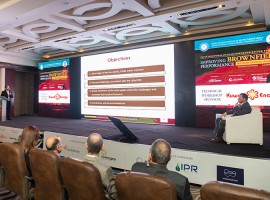By Mark Thurber, Board Member of the Middle East office of the Andrews Kurth Law Firm
Joint ventures, unincorporated or otherwise, are the most common structure to undertake projects in the energy and petrochemical industries. There are as many reasons for seeking out a partner as there are projects, including gaining access to technical know-how, combining complementary lines of business, and obtaining entry into an unfamiliar regulatory, cultural or commercial environment.
But the most common reason for joint venturing is to spread financial risk. Principally this is driven by the size or projects in these industries; even established players with a deep balance sheet have preferred to diversify their risk and stretch their capital by bringing in partners to share in the ups and downs of larger projects, thus expanding the number of projects a company can add to its portfolio. This is important not only for the obvious need to spread financial risk. Just like individuals, companies also have CVs – the more projects they undertake the greater their savvy and experience; they become better companies.
Joint ventures are not usually short term. Construction and development schedules for a major project are often measured in years. IRRs are usually more in the investment grade range rather than speculative, meaning that recovery of capital and obtaining targeted returns can stretch into decades. Accordingly, it is not surprising that joint ventures come with a high failure rate. Not only are the individuals who formed the enterprise long gone by the time their project matures, but the investment climate (dependent on myriad political and economic factors) will shift throughout the life of the project. The reality is that very few projects end up with the same original ownership, in fact many are designed with exit strategies. Having a realistic view of the need to prepare for the unknown, while planning for success, is a condition to establishing a stable joint venture relationship. Aside from the goal of reaching a benchmark return, the need to avoid cash-draining and debilitating litigation should be a central concern in the formation of any long-term business relationship. Accordingly, there are a number of factors to consider in structuring a large energy, infrastructure or industrial project to remain healthy throughout its planned life cycle. Following is a discussion of three primary factors that need to be done well if the joint venture is to remain healthy over the long term.
Partnering Correctly
The first factor is picking the correct partner. This is particularly crucial in an international setting where differences in culture, economic strength, and business acumen, to name a few, can lead to significantly disparate expectations, business practices, and appetite for risk. Obviously, any prospective joint venture partner should have the technical, financial and legal ability to perform its designated tasks in developing the project. Further, the partner’s skill sets must not only be sufficient to carry out its side of the project, but should be complementary to the skill sets of the other partner, so as to maximize the opportunity for continued progression towards completing the project. And in today’s legal environment where authorities aggressively target improper business practices, it is ever more mandatory that any joint venture partner must possess impeccable ethical credentials.
Aside from these qualifications, which are essential, the partners must above all be compatible. It does no favor to either side to spend the considerable time and resources necessary to develop a modern energy or infrastructure project only to see the process bogged down in failed expectations and mistrust. Trust can only be developed through extensive face to face interaction. Prior to signing up, the partners must learn everything they can about each other. They must spend time together, and discuss the project endlessly from every perspective. Only a minor portion of a project is driven by its legal framework. Most of the day-to-day activities are conducted outside the context of any contractual overlay, relying on trust and a healthy working relationship. To a large extent, contracts are in place to record the parties’ original intent and as an arbiter, in order to prevent litigation, of how a dispute is to be decided. In a successful joint venture the parties in many cases will rarely consult the underlying contracts as a guide to behavior. Trust in the ethics of the other party, comfort in working together, and confidence in the abilities and working style of the partner are both precursors to and requirements for success.
Governing Correctly
The second factor is voting rights. Investment levels are invariably given; primary weight and will usually control voting rights. A stable relationship depends on rewarding the providers of capital appropriately; but in the context of promoting long-term stability other factors should be considered. The most stable partnerships are those in which both parties bring roughly equivalent value to the table and are treated accordingly. Many business professionals will assume that in order to promote efficiency of project development and operation, one partner should be in charge: according to this view, taking advice from the minority partner, even direction on certain narrowly specified issues when needed is fine, but essentially at the end of the day a tie-breaker will be required. These assumptions have been shown through experience to not have universal application. In fact, though counterintuitive, partnerships of equals can be messy, but often provide the most stable ground for longevity.
One client of ours has engaged in energy infrastructure development for about 12 years under a joint venture arrangement with a key investor. The investor is a New York-based private equity fund, while the client is a Texas-based developer. They are different in almost every way, especially culturally. They have clashed from the beginning, disagreeing about almost everything. Nevertheless, despite not having been successful to date, they are still together, working through every decision on a 50/50 basis, still hoping to finish their first project. While the lure of being able to direct the key business decisions of the venture will push some companies into unequal partnerships, experience has shown that the more difficult equal partnership is the one that survives and avoids litigation.
In some jurisdictions legal restrictions may prevent the venturers from entering into a simple 50/50 relationship, but ventures can often be formed in a way that effectively implements the concept, while complying with local law.
Structuring Correctly
The third factor is the proper structuring of the joint venture to either facilitate easy exit – some developers are just that, they develop the project intending to turn it over to others – or to facilitate a stable and long-term operating environment for the project. Structuring viable exit ramps is a technical, legal exercise and emphasizes the need for development expertise (speed, capital, local know-how) over operating expertise (orientation to long-term returns, core business compatibility, and a continuing plan to develop deep local connections to ensure project longevity). Despite best-laid plans, however, it is a fact of life that people change, markets evolve, and companies cycle through their natural lives. Projects that survive must be structured to outlive the people and companies which initiate them, and even to outlive the governments and legal structures under which they were established.
Stated simply, the object of a joint venture participant, having found the perfect partner, should be to assume that after a few years, things will not be so perfect. The people running the project will have little or no knowledge of the dynamics that led to the project’s formation, nor even much care about the original expectations of the founding partners. Accordingly, the documents underlying the venture must plan for disagreements and unexpected developments that threaten the original assumptions of the project, and in some cases the project itself. They must attempt to anticipate, in a comprehensive fashion, the challenges that the project is likely to face through its lifetime and to prescribe appropriate courses of action for those eventualities. For instance:
The partners’ know-how and other intellectual property should be protected, such that their property will retain value in the face of the certain but unknown changes that will eventually threaten the ongoing viability of the project.
Tax structuring should answer the needs of both partners, yet remain flexible in an environment of changing law.
Where equal voting is instituted, consideration should be given to priority rights of one partner over the other in certain key aspects of the project’s development and operation. Where deference is to be given to one partner over another, those rights and expectations should be clearly defined; each partner should be accorded clear rights and direction as to its role in the project.
Withdrawal rights should be carefully considered so as to provide maximum flexibility to the partners while nevertheless protecting the viability of the project. Similarly, rights to compete or restrictions on competition should be clearly delineated, either expressly permitted or prohibited, with clearly defined geographical and time-based parameters.
Dispute resolution should be in a neutral forum that is equipped from a legal and traditional standpoint to address business disputes from around the world. A well-drafted arbitration clause specifying a distant, expensive forum can often be an effective litigation deterrent.
At the end of the day, no joint venture will be perfect, and unexpected events will occur randomly throughout the project life. But through careful planning, striving for flexibility and anticipating problems, the parties can maximize their odds of achieving a long-lived, profitable venture.








